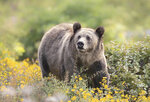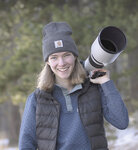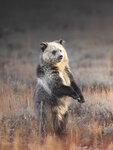Mostly Cloudy, 67° F
Unlike most high school kids, environmental photojournalist Julia Cook spent much of her free time in the basement of the Draper Natural History Museum stripping rotting meat from the skeletons of …
This item is available in full to subscribers.
The Powell Tribune has expanded its online content. To continue reading, you will need to either log in to your subscriber account, or purchase a subscription.
If you are a current print subscriber, you can set up a free web account by clicking here.
If you already have a web account, but need to reset it, you can do so by clicking here.
If you would like to purchase a subscription click here.
Please log in to continue |
|






Unlike most high school kids, environmental photojournalist Julia Cook spent much of her free time in the basement of the Draper Natural History Museum stripping rotting meat from the skeletons of various animals; bears, wolves, mountain lions. A half-dozen years later, you can still find her there volunteering to do work many would turn their nose up to.
“Sometimes it is a bit smelly,” Cook said during a recent lecture at the museum.
Cook was an intern with the Wyoming Game and Fish Department when a grizzly bear was brought in that would eventually be donated to the museum for a skeletal articulation. She helped skin and deflesh the carcass for the project prior to assisting Lee Post, one of the world’s leading wildlife articulation specialists, in rebuilding the remains for display.
“When you look at the skeleton, it looks nothing like a human. But their paws look eerily like a human’s [hands],” she said while participating in the special project.
Her scientific curiosity started at a young age. While in elementary school Cook had found a bug she wanted to research and reached out to the high school science department for answers. Coincidentally, that’s when she also met one of the Yellowstone ecosystem’s top nature photographers, Amy Gerber, a former Cody High School science teacher who recently became a full-time professional wildlife photographer.
“Julia has always loved nature, science and the great outdoors,” Gerber said. “Cook is very bright and was a great student.”
Yet, despite Cook twice traveling with other students on short-term scientific studies abroad with Gerber, she still hadn’t decided on a career direction. Actually, it wasn’t until the oddly isolated period of the global pandemic that Cook picked up her first camera.
While studying virtual classes at the University of Wyoming for a degree in Environment and Natural Resources, Cook fell in love with wildlife photography. It’s hard to say many positive things about COVID-19, but when she came back to the Greater Yellowstone Ecosystem from Laramie during the global pandemic she was able to explore environmental photojournalism.
“I just sort of picked up a camera as a creative outlet during that time,” she said. “I got hooked really, really quickly.”
It’s not exactly a straight line from cleaning bones for skeletal articulation to wildlife photography, but it was the right move for Cook. Her portfolio was featured during the Draper Natural History Museum’s Lunchtime Expedition lecture last week, where she announced she was dedicating her life to environmental photojournalism.
Her first big thesis, titled “This is Grizzly Bear Country: Human Grizzly Interactions in the Yellowstone Ecosystem,” deals with identifying different ways to mitigate human wildlife impact, especially on roads in Wyoming.
Gerber was there to help with the transition to photography. They traveled to Jackson several times to photograph the famous sow 399 and her cubs and spent a lot of time together on the North Fork and in Yellowstone.
Cook has been documenting the phenomena of female grizzly bears avoiding areas occupied by adult males to reduce risk of infanticide. In many cases, that puts the females and their young closer to humans.
“Male bears tend to be very skittish around human developed areas and tend to stay a lot farther back into the backcountry,” Cook said. “Females have learned to stay close to the road in order to protect the cubs. And that’s what we refer to as a roadside female.”
Unfortunately, the road isn’t always safe. It has become a common incident in recent years where motorists, possibly rushing to Yellowstone in hopes of seeing a bear, hit and kill the magnificent creatures on or near roads leading to the national park. There are also issues with bears becoming too acclimated to humans, which can also be deadly to the species.
The early mornings and long days on the road doing research were a wakeup call for the naturalist, who admits she isn’t overly fond of 3 a.m. alarms. But the constant travel was also a time for family bonding.
Cook’s parents, Rick and Laura Cook, often travel with Julia while she works. She said they are responsible for her passion for wilderness and the wildlife that live there.
“The biggest thing they did for me in terms of my wildlife photography was helping spark my joy for nature and the outdoors from an early age through trips into Yellowstone, camping on the North Fork, and going fishing, along with other outdoor activities,” she said.
Laura is a dance teacher, which helped Julia develop a love for creativity. Seeing her mother succeed in a career based on something creative gave Julia confidence in pursuing photography, “something more traditionally viewed as just a hobby,” she said.
The mother/daughter team traveled together to Alaska for a month as Julia worked on her project, which was partially funded through a grant from the Honors College at the University of Wyoming.
“That was my gas money for the year,” she said.
Rick is retired, giving him more time for camping and fishing trips and early mornings in Yellowstone.
Having volunteered at the Draper Natural History Museum for years, Julia Cook has developed professional relationships with curators and scientists at the Buffalo Bill Center of the West. Corey Anco, curator of the Draper, said Cook is dedicated to ethical wildlife photography in order to keep wildlife wild and allow them to behave naturally without interference.
“Her overall goal in photography is to capture impactful images of native wildlife that highlights the wildness of the American West while inspiring others to care about wildlife conservation,” he said.